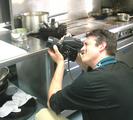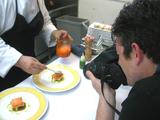Mistral: (1) the cool, dry, north wind of Provence (2) fr Latin magister=teacher, a "Master Wind" (3) by extension, change, motion, improvement.
It's just past six, and the earliest guests have already arrived at Mistral, the elegant 12-table eatery on Blanchard's slope from First to Second: a trio of Japanese visitors drinking champagne, the first of several international VIPs in tonight's book. As it happens, they're associated with one of cable TV's top cooking shows and they've come to pay homage to the one chef in Seattle who actually turned down their requests for a guest appearance.
But the sun is still high over Elliott Bay, and Mistal's owner and chef, 35-year-old William Belickis, is playing stickball in the parking lot. ...
Tonight, a commercial photographer is on hand, gathering images for Mistral's new website. Jim Garner, wielding a monster Contax 645 camera outfitted with a Kodak 16-megapixel digital back, shoots close-ups of pots, pans, dishes, vegetables, fish, chops, plates; he poses William in a halo of light diffused by gauze curtains, snaps the dishwasher destemming thyme, catches the chef in a blur at the stove, captures the waiter pouring an apéritif.
Note: a slightly different version of this post also appeared in the June 2004 issue of the Belltown Messenger. Follow this link to read it as a PDF.
Ballgame over, William and his executive chef Charles Walpole--a stocky, stoic gent in a bandana who's been on hand from the start--will spend the next four hours preparing a series of five-, six- and seven-course dinners for about two dozen lucky palates. Tasting menus, if you will, in the classical grand tradition of French haute cuisine. No dumbing-down, no concessions, no casual-Friday lowering of standards, no democratization of tastes. This is as pure as pure can be. With an idealism that's almost blinding, never filled with doubts or second thoughts about his goal, William forges ahead, and it seems he's finally getting traction.
For now, the (to outside appearances) unsynchronized activities of a small restaurant kitchen: William is in the cool garde-manger, whipping up desserts. A chocolate soufflé batter, a dozen flavors of homemade sorbet.
Three feet away, behind the blazing stove, Charles is preparing foie gras. The goose liver arrives in a vacuum-sealed pouch from Artisan Farmers in Sonoma. Its cut into inch-thick medallions and sautéed in butter, plated atop a dollop of rhubarb puree and garnished with two crisp-dried slices of Granny Smith apple. The result is a flavor explosion: simultaneously sweet and tart, soft and crunchy, rich and austere.
Another course this night is pea soup. Yeah, right, pea soup. But it's freshly shelled peas, my friend, shelled by William himself not 15 minutes before, poached in homemade poultry stock enriched with herbs, pureed and seasoned with fresh herbs. While the soup is being readied, Charles sautés giant scallops, which he centers at the bottom of the dish, surrounds with the luscious cream of green peas, crowns with a dollop of mandarin foam and garnishes with lavender and thyme blossoms.
The waiter confirms '"two scallops on table three," crosses off a line on the order ticket, scoops up the dishes and sails smoothly into the dining room. The plates come back empty, virtually scraped clean. Dishwasher Miguel Soltero busies himself carving an apple into a swan. He's clearly destined for bigger things.
William himself trained on-the-job. He started at 15, working in a private club, a butcher shop, and in the prestigious kitchen of David Bouley in New York. Ten years ago he headed for parts west. A season in Cannon Beach, another in Portland. Then Fullers, which was once Seattle?s top restaurant until the Sheraton chain abandoned fine dining, and finally the Salish Lodge, where he learned more about the business side of being a chef.
Mid-1999 in Belltown, William walks past a kosher deli called Betay Avone. Within half a block he?s nearly flattened by a blast of wind; the name sticks: Mistral is born. The mantra, too: constant improvement.
Last month, he finally moved from Capitol Hill into the McGuire, three blocks away. He's now fully committed to Belltown, and worships at Saito's sushi bar.
The upgraded website is scheduled to go live in a couple of weeks. Its William's one concession to what he otherwise disdains as "marketing." He's proud of Mistral's rating in the Zagat guide, where his reputation for quality has put him at the forefront of Seattle's dining scene two years in a row: 29 points for food. The best of the best.
He knows that "cultural tourists," who travel for enrichment rather than beaches, will seek him out, but he's not particularly keen on cozying up to people like hotel concierges who might be able to send a few diners his way. Or cruise ship pursers recommending a shore excursion.
Mistral is a demanding restaurant: you can't just stroll in off the street for a salad. There are plenty of "upscale casual" restaurants around Belltown--the Tom Douglas empire, Zoë, Axis, Flying Fish--but far fewer "fine dining" establishments. And even Cascadia has a 3-course, $25 menu ... whereas Mistral's 5-course "Market Menu" runs $65. The only other options: a 7-course "Tasting Menu" for $75 and the full-bore "Mistral Tasting Experience" for $90. So you?re going to spend at least $100 to $150, and, more to the point, you're going to spend well over two hours enjoying the experience.
That's very much the European tradition of haute cuisine, gastronomy at its highest. In Seattle, the only other practitioner is Thierry Rautureau, at Rover's, in Madison Park, and he's just taken the first step down the slippery slope of compromise, offering a la carte choices in addition to the prix-fixe tasting menus ($125 for 8 courses, $90 for 5).
Clearly, not for everyday, nor for everyone. William wants his staff to ask lots of questions before accepting a reservation: how did you hear about us, what's the occasion, so that there's no misunderstanding at tableside. The result, ideally: newcomers are welcomed as special guests, and return visitors greeted as old friends.
William's patience is paying off, too. Zagat's endorsement, the CitySearch and NWSource websites, his terrific word-of-mouth reputation, the four-diamond rating from Triple-A, his own new website. The slowly improving economy, the renaissance of domestic tourism.
This year, Mistral is serving about 100 dinners a week, an increase of 50 percent over 2003. A sure sign of progress.
Even so, as William would be the first to admit, there's room for improvement: even one additional table a night could mean an extra thousand bucks a week.
Think about it: just one hotel concierge?s recommendation a day. It seems so simple. But William is shy, and he?s proud.
"I'm here if they want to come see me," he says, with the unaffected certainty of a true believer, a confident artist, an accomplished craftsman.


